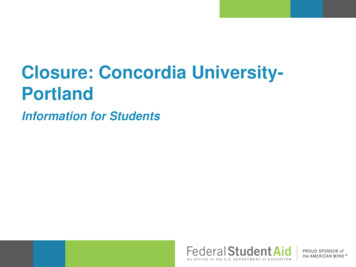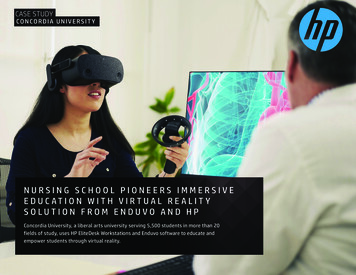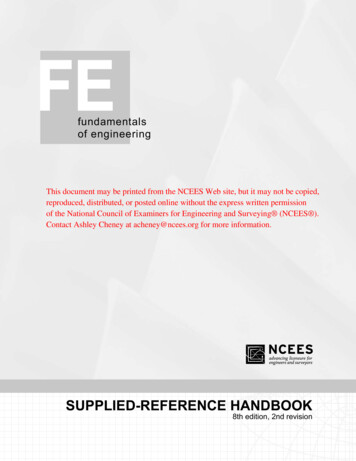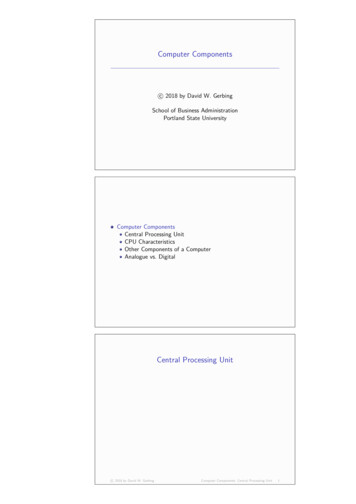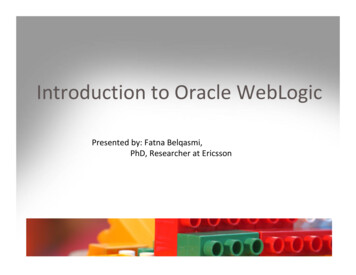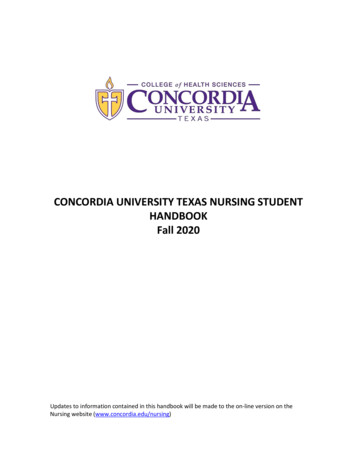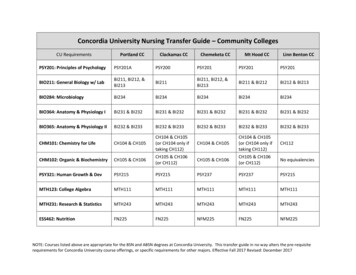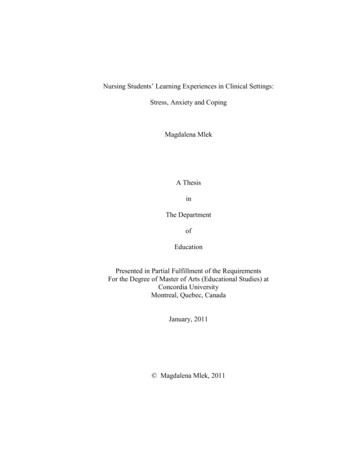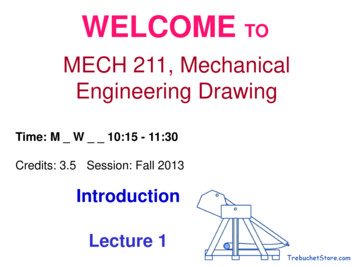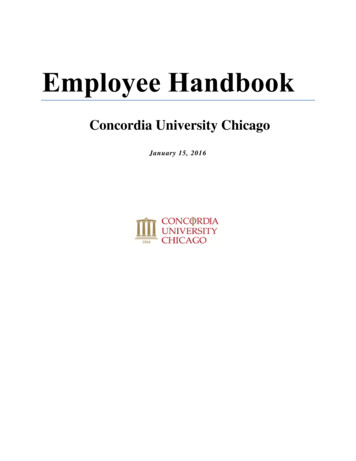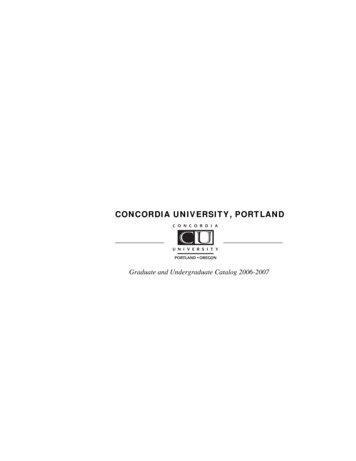
Transcription
CONCORDIA UNIVERSITY, PORTLANDGraduate and Undergraduate Catalog 2006-2007
TABLE OF CONTENTSPresident’s WelcomeGeneral InformationAttending Concordia UniversityPrograms of StudyStudent ServicesCo-curricular Opportunities3410101215Undergraduate EducationAdmissionsTuition and FeesFinancial AssistanceAcademic Information and PoliciesGeneral Education RequirementsHonors ProgramMinorsCollege of EducationCollege of Theology, Arts & SciencesSchool of Management20212229324348515982107Graduate EducationAdmission, tuition andFinancial AssistanceAcademic Information and PoliciesCollege of EducationSchool of Management127127135144182Course Descriptions186Appendices3212
Concordia University, PortlandGraduate and Undergraduate Catalog 2006-2007Use of This CatalogWhile this catalog is provided for guidance in course selection and program planning,students are expected to confer with their academic advisors for precise informationconcerning their academic programs. Every effort is made to ensure the accuracy of theinformation in this catalog. However, it is not considered a binding contract. Otherpublications which reflect additional policies of Concordia University include the StudentHandbook and the Faculty Handbook.The statements made in this Academic Catalog constitute official policies of ConcordiaUniversity. These policies are subject to change by the President, the Board of Regents,and the faculty. Courses listed in this catalog are subject to change through normalacademic processes. Changes to the curriculum are published in the program outlines andthe university Schedule of Classes. Concordia University reserves the right to, at anytime, change or withdraw courses, fees, rules, and calendar, as well as other regulationsaffecting the student body.PRESIDENT’S WELCOMEConcordia is a wonderful place to go to school. We provide our students with a relevantand meaningful higher education experience within a Christian context. Our students arechallenged in the classroom to reach high academic standards while integrating faith andlearning to prepare them to be leaders in the home, workplace, and in their communities.As you investigate this catalog and, more importantly, talk with the faculty and students,you will see that we create a learner-centered environment with an emphasis on lifelonglearning and service to the communities in which we live. As a result, as a part of theiracademic program, every student participates in a practical experience directly related totheir chosen field of study and profession. You will be building your résumé as you earnyour degree.Concordia is a faith-based institution which has graduated thousands of students who aremaking a difference in our world. Concordia is making a difference in the lives of itsstudents and our broader community. A Concordia education provides students with theexperiences and skills to become leaders and make a difference in the world that needshelp and hope.I invite you to join us and transform your life and the lives of those around you.Charles E. Schlimpert, Ph.D.President3
Concordia’s VisionChristian commitment, educational excellence, and service to students are the core valuesupon which Concordia University’s mission, vision, and daily operations are built.Concordia University: models Christian witness and service.graduates leaders who serve.is firmly grounded in the Liberal Arts.has critical mass.combines quality and affordability.uses innovative educational delivery systems.enjoys a strong regional reputation.benefits from significant volunteer human service.provides a sound institutional infrastructure and effective institutionalmanagement structures.Concordia’s Rich HistoryConcordia opened its doors for the first time at its current location in 1905. The schoolbegan as a four-year academy to meet the needs of the region for pastors and schoolteachers for the Lutheran Church-Missouri Synod. The campus has evolved into auniversity that offers a solid liberal arts education, pre-professional programs,professional church work programs, and undergraduate and graduate degrees in educationand business. The campus’ 1,500 students come from all over the United States and theworld, but primarily from the Pacific Northwest.Concordia University is a Christian university preparing leaders for the transformation ofsociety. Located on 13 acres in a residential neighborhood of Portland, Concordia’smission drives all planning in academics and future directions. The campus builds on itsstrengths, pursuing programs that will assist students to prepare for work or to enhancetheir pursuit of lifelong learning. Students, staff, and faculty — the Concordia community— are valued as the most important components of this campus, as all strive toencourage, support, and equip for service and fulfillment.Concordia History Concordia opens as a four-year academy for boys to meet the needs of the area forpastors and parochial school teachers for the Lutheran Church-Missouri Synod.The junior college is added.Concordia becomes co-educational.Accreditation is achieved with the Northwest Association of Schools andColleges.Concordia becomes a four-year college.The first students graduate with Bachelor’s degrees.International Student Programs are initiated.Health Care Administration and International Executive Program are added.Accelerated Degree Program is added.Secondary Education is added.4
dia exceeds enrollment of 1,000.Concordia College becomes Concordia University – Portland, a member of theConcordia University System.Distance learning classes and Concordia University System visitingStudent program begin.Master’s degree programs in teacher education offered by the College ofEducation.Health Care Administration program is approved for associate membership to theAssociation of University Programs in Health Care Administration; Director ofChristian Education program is expanded with calling of first full-time director.New 245-bed residence complex opens, doubling resident student population.Master of Business Administration offered by the School of Management.The first fully online program, the M.Ed., is offered.Northwest Association of Schools and Colleges (NASC) becomes NorthwestCommission on Colleges and Universities (NWCCU).Class Schedule begins at 7:30 am.Bachelor of Science in Nursing program receives accreditation from the OregonState Board of Nursing.Accreditation, Associations and Memberships Concordia University is accredited by the Northwest Commission on Collegesand Universities at the undergraduate and graduate levels.Concordia was granted well-established/experienced instructional status in 2000,and Level II status in 2004.Teacher education programs are accredited by the Oregon Teacher Standards andPractices Commission.Business programs are accredited by the International Assembly for CollegiateBusiness Education (IACBE).The nursing program has initial accreditation from the Oregon State Board ofNursing.Concordia University is approved by the US government and the state of Oregonfor the education of veterans.The University is a member of the Oregon Independent Colleges Association andthe Oregon Independent College Foundation.Documents pertaining to accreditation, licensure, and approvals are available for reviewin the Office of the Provost.The Concordia University System (CUS)Concordia University Portland is the Pacific Northwest university of the ConcordiaUniversity System. The CUS is a unique, nationwide consortium. It is a ten-school,intercampus partnership designed to provide enhanced educational experiences forstudents, efficient use of resources, and unique interinstitutional programming. A varietyof initiatives are currently underway for the CUS.The CUS is a confederation of the ten Concordia colleges and universities in the UnitedStates that are associated with the Lutheran Church-Missouri Synod (LCMS). Each5
college and university maintains its individual identity and autonomy, and is strengthenedby the association with the sister institutions.An area Board of Regents, elected by the LCMS in convention, carries the responsibilityfor the institution’s operation and control. The President of the university serves as theChief Executive Officer of the Board. These initiatives include the continueddevelopment of distance learning opportunities, coordinated study abroad opportunities,“seamless” and easy interinstitutional transfer of students, short term courses of study onvarious campuses, and sharing of faculty and other institutional resources.The member institutions of the Concordia University System are:1. Concordia College, Ann Arbor, Michigan2. Concordia University, Austin, Texas3. Concordia College, Bronxville, New York4. Concordia University, Irvine, California5. Concordia University, Mequon, Wisconsin6. Concordia University, Portland, Oregon7. Concordia University, River Forest, Illinois8. Concordia University, St. Paul, Minnesota9. Concordia College, Selma, Alabama10. Concordia University, Seward, NebraskaThe LCMS also elects a Board for University Education (BUE) that implements andarticulates the operation of the various synodical schools. Through its Executive Director,it serves as liaison between the national church and each school’s Board of Regents.WorshipWorship is placed at the center of life and activity at Concordia. The worship programguides the spiritual tone and stimulates faith development in all aspects of the Concordiaexperience. Through the worship program, students, faculty, and staff are led by the HolySpirit to become actively involved in their relationships with God and His children, andin understanding the dynamic potential offered by a Christian lifestyle.Chapel attendance, while not mandatory, is encouraged of all Concordia students, faculty,and staff. Chapel services are conducted at St. Michael’s Lutheran Church at theNortheast corner of campus Monday through Friday at 10:30 am, and in the residencehalls on Wednesday evenings. Morning chapel is conducted by faculty members, guestspeakers, and students. Evening devotions are student-led. Residence hall chapels areavailable at all times for student use. In addition, Concordia has joined together with St.Michael’s congregation to pursue a joint vision of ministry in which St. Michael’sreaches out to minister to the students, faculty, and staff at Concordia. The pastor of St.Michael’s is the campus pastor, and the campus worshipping community operates underSt. Michael’s auspices. To be involved in Concordia’s campus worship program, contactthe Student Services Office.6
Location and FacilitiesConcordia University occupies an attractive ten-acre campus with adjacent land forexpansion. The Hagen Center Library and Dining Hall, the Physical Education Building,the Fine Arts Building, and Luther and Centennial Halls are the primary facilities oncampus. Spacious and modern residence halls, student lounges, and recreation areasensure residential students are comfortable and have a well-rounded experience atConcordia.Concordia maintains a video-conferencing classroom used for two-way audio videoclasses, meetings, and interviews, as well as several “smart,” technologically-richclassrooms.The school’s other facilities include the administration building, classrooms andlaboratories, spacious and modern residence halls, student lounges, recreation areas,faculty offices, and athletic fields.Campus center facilities, classrooms, and the largest residence hall, East Hall, arecompletely equipped for use by students who are physically challenged. Access to otherfacilities will be achieved by consulting Concordia’s staff for assistance.Concordia University is located in a quiet residential neighborhood of Northeast Portland.Only ten minutes from downtown Portland or the airport, students have easy access to therich cultures of Portland. The Oregon Symphony, the Portland Opera, Oregon BalletTheatre, and traveling productions complement the athletic events that include NBAbasketball with the Trailblazers. Recreational activities such as skiing on Mt. Hood,sailing on the Willamette, and windsurfing on the Columbia River are easy drivingdistance from the campus. Innovative and diverse restaurants, Saturday Market,museums, the Oregon Zoo, and a myriad of other activities and educational experiencesare available to Concordia students.Tri-Met, Portland’s transportation system, and MAX, Portland’s light rail system, providestudents with ready access to Portland’s offerings. A very nice grocery store andpharmacy are within walking distance of the campus.LibraryThe university libraries are an integral part of the educational environment at Concordia.The main Library, located in the Hagen Campus Center, is open 100 hours per week andprovides space for individual study and group interaction. Librarians are available inperson and via telephone or e-mail to assist students in identifying, evaluating, andlocating the information needed to their support course work.The Libraries’ print collections number over 75,000 volumes and support studies in thearts and sciences, business, education, nursing, theology, and athletics. The libraries’collections also include thousands of video tapes and DVDs. The collections are arrangedby the Library of Congress Classification System. The cu Libraries are also part of the7
OPALL Consortium, with access to over 550,000 volumes among the consortium’s sevenregional campuses.The Concordia University libraries provide electronic access to over 15,360 full-textjournal titles and approximately 10,000 books. Statistical and other information isavailable through dozens of databases. All electronic resources are available to anystudent with Internet access, regardless of the student’s physical location (dorm, home,office, etc.).The Main CU Library is also home to the Northwest Center for Children’s Literature(NWCCL), a non-circulating preview collection of the most recently published children’sand young adult literature. There is also a Science Library located in Luther Hall alongwith the science faculty. All materials in the NWCCL and the Science Library are notedin the CU Libraries’ online catalog.Computer FacilitiesReady access to computer resources has become essential for student success in highereducation. Students use computers to prepare course materials; communicate with peers,professors, and staff; access information and resources; and for engaging withinstructional materials. As a result, Concordia University requires that all students own,or have ready and unlimited access to, a computer that meets the university-specifiedminimum computing standards. Two university instructional computer labs, locatedupstairs in the library (Hagen Campus Center Building), are available for student useduring regular library hours when lab classes are not in session.A Help Desk is available to resolve issues during regular library hours. Get moreinformation on expected minimum computer requirements and compatibility information.Resident students will find one port per student per room available for connecting to thecampus network (10 or 10/100 Ethernet connector and Cat 5 cable required). ITSpersonnel can provide information on gaining access to the campus network; however,due to resource and liability restrictions, ITS can only provide limited technical supportfor students’ personal computers.Note: Concordia University is primarily a PC/Windows-based environment. While otheroperating systems may be compatible with the network, only limited support can beoffered for connectivity for other systems.The Center for Excellence in Learning and Teaching (CELT)Concordia University created the Center for Excellence in Learning and Teaching(CELT) to enhance diverse learner-centered teaching. While CELT primarily exists foreducators in order to enhance their contribution to prepare leaders for the transformationof society, Concordia students benefit as CELT’s values are upheld among teachingfaculty: Education should be “learner-centered,” focusing on the attributes, needs, andcontext of the learner.8
Learning is a natural process that can be heightened through the crafting of aneffective learning environment.The faculty at Concordia are gifted, caring instructors, and the key influence inproviding a learner-centered, mission-driven teaching environment at Concordia.The selection of instructional strategies, methodologies, and delivery modes in theclassroom are best based upon the learner and the instructional objectives.The strongest instructional objectives are consistent with the university’s missionand vision, and include a focus on appropriate cognitive, psychomotor, andaffective outcomes.Learner-centered education incorporates effective and appropriate formative andsummative assessment strategies.Effective use of instructional technologies can greatly enhance the learningenvironment.Research and innovation about teaching and learning will provide futureopportunities for development of cu faculty.CELT serves the campus community in course design, discussing the teaching andlearning processes, and in thinking through the development of the best in distanceeducation. Faculty participate in development opportunities as well as in one-on-onetraining. CELT staff has helped to equip online instructors and challenge all faculty tothink deeply about the teaching and learning processes.Northwest Center for Children’s Literature (NWCCU)The NWCCL opened its doors at Concordia in September 2004. Housed in the mainlibrary, the NWCCL is both a space and a service. A joint initiative of Concordia’sCollege of Education and the University Libraries, the NWCCL provides access to thebest in children’s literature and related resources to prepare future leaders that lovereading and appreciate lifelong learning. The NWCCL collection is non-circulating andincludes: Review copies of nearly all trade books published each year in the United States.Recommended children’s and young adult trade books.Notable current, retrospective, and historical books for children and young adults.Current and historical reference materials related to literature for the young.Children’s and young adult books by Northwest authors and illustrators.Small and alternative press books published in the United States.Endowments of private collections.Gifts of complete book sets (Both specific-author and topical).The NWCCL offers Oregon and Southwest Washington librarians, teachers, students, andothers informational and educational services based on the collection; and supportsteaching, learning, and research needs related to children’s and young adult literature.This is a tremendous resource for Concordia’s education students.9
ATTENDING CONCORDIA UNIVERSITYConcordia University has three primary academic colleges: Education (COE),Management (SOM), and Theology, Arts & Sciences (CTAS). Students who are not yetdecided about professional goals can explore career options and gain a liberal arts baseduring this exploration.Concordia University admits students of any religion, race, color, national and ethnicorigin, sex age, sexual orientation and disability to all the rights, privileges, programs,and activities generally accorded or made available to students at the University. It doesnot discriminate on the basis of religion, race, color, national and ethnic origin sex, age,sexual orientation or disability in administration of its educational policies and programs,admission policies, merit scholarships and loan programs, and athletic or otheruniversity-administered programs. Complaints or charges should be filed with theUniversity's Title IX coordinator."Concordia University welcomes applications from all students who have demonstratedthat they are able to successfully participate in and benefit from the c
1995 Concordia College becomes Concordia University – Portland, a member of the Concordia University System. 1996 Distance learning classes and Concordia University System visiting Student program begin. 1996 Master’s degree programs
